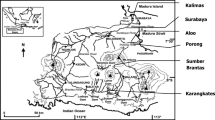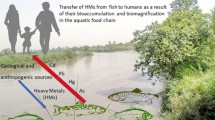Abstract
Purpose
The aim of this work was to assess the levels of copper and zinc in fish from the main freshwater ecosystems of Moldova, in relation with species, habitat, age, sex, season, and development stage.
Methods
Fish from Cyprinidae and Percidae families (Cyprinus carpio, Carassius auratus gibelio, Rutilus rutilus heckeli, Abramis brama, Aristichthys nobilis, Hypophtalmichthys molitrix, Sander lucioperca) were collected from Prut and Dniester rivers, Cuciurgan, Dubasari, and Costesti-Stanca reservoirs, and ponds of farms in the Dniester delta. The Cu and Zn content of fish tissues (skeletal muscles, liver, gonads, gills, skin, and scales) was determined by flame atomic absorption spectrophotometer AAS-3, of water by graphite furnace HGA 900 of AAnalist 400.
Results
The level of heavy metals accumulation in muscles of immature fish follows their dynamics in water. The highest concentration of zinc was registered in the gonads of mature fish, and of copper—in the liver. The lowest Cu and Zn contents were recorded in the muscles and are in the United Nations Food and Agriculture Organization safety-permissible levels for human consumption. Cu and Zn contents in muscles of fish depend on specimen age. Their level in fish gonads was sharply increasing during pre-spawning period. During the early developmental stages, the metal concentration in fish eggs and larvae varies within wide limits, but the accumulation pattern is similar in the investigated species.
Conclusions
The fish represent one of the most indicative factors for the estimation of trace metals pollution in freshwater systems and this is important not only for monitoring purposes, but also for the fish culture ones.






Similar content being viewed by others
References
Alhas E, Oymak SA, Karadede Akin H (2009) Heavy metal concentrations in two barb, Barbus xanthopterus and Barbus rajanorum mystaceus from Atatürk Dam Lake, Turkey. Environ Monit Assess 148:11–18
Amundsen PA, Staldvik FJ, Lukin AA, Kashulin NA, Popova OA, Reshetnikov YS (1997) Heavy metal contamination in freshwater fish from the border region between Norway and Russia. Sci Total Environ 201:211–224
Analytical Methods for Atomic Absorption Spectroscopy (1996). The Perkin-Elmer Corporation
Andreyev V (1991) The content of microelements in the Acipenser Stellatus Pallas early development stages under artificial and natural reproduction conditions. Acta Ichthyologica et Piscatoria Fasc. I(XXI):65–72
Authman MN, Abbas HH (2007) Accumulation and distribution of copper and zinc in both water and some vital tissues of two fish species (Tilapia zillii and Mugil cephalus) of Lake Qarun, Fayoum Province, Egypt. Pakistan J Biol Sci 10:2106–2122
Burger J, Gochfeld M (2005) Heavy metals in commercial fish in New Jersey. Environ Res 99:403–412
Dragun Z, Podrug M, Raspor B (2009) Combined use of bioindicators and passive samplers for the assessment of river water contamination with metals. Arch Environ Contam Toxicol 57:211–220
Dragun Z, Erk M, Ivankovic D, Zaja R, Marijic Filipovic V, Raspor B (2010) Assessment of low-level metal contamination using the Mediteranean mussel gills as the indicator tissue. Environ Sci Pollut Res 17:977–986
Firat O, Kargin F (2010) Response of Cyprinus carpio to copper exposure: alterations in reduced glutathione, catalase and proteins electrophoretic patterns. Fish Physiol Biochem 36:1021–1028
Freitas Terra B, Gerson Araújo F, Ferreira Calza C, Tadeu Lopes R, Pires Teixeira T (2008) Heavy metal in tissues of three fish species from different trophic levels in a tropical Brazilian river. Water Air Soil Pollut 187:275–284
Ghedira J, Jebali J, Bouraoui Z, Banni M, Guerbej H, Boussetta H (2010) Metallothionein and metal levels in liver, gills and kidney of Sparus aurata exposed to sublethal doses of cadmium and copper. Fish Physiol Biochem 36:101–107
Golovanova IL (2008) Effects of heavy metals on the physiological and biochemical status of fishes and aquatic invertebrates. Inland Water Biol 1:93–101
Hellou J (2011) Behavioural ecotoxicology, an “early warning” signal to assess environmental quality. Environ Sci Pollut Res 18:1–11
Jezierska B, Ługowska K, Witeska M (2009) The effects of heavy metals on embryonic development of fish (a review). Fish Physiol Biochem 35:625–640
Kuzmina VV, Ushakova NV (2008) Process of exotrophy in fish. Effect of heavy metals - Zn and Cu J Evol Biochem Physiol 44:430–439
Ministry of Agriculture, Fisheries and Food (1995) Monitoring and surveillance of non-radioactive contaminants in the aquatic environment and activities regulating the disposal of wastes at sea, 1993, Aquatic Environment Monitoring Report No. 44, pp.68, Directorate of Fisheries Research, Lowestoft, UK
Mol S, Özden Ö, Ahmet Oymak S (2010) Trace metal contents in fish species from Ataturk Dam Lake (Euphrates, Turkey). Turk J Fish Aquat Sci 10:209–213
Nauen CE (1983) Compilation of legal limits for hazardous substances in fish and fishery products, United Nations Food and Agriculture Organization, FAO Fishery Circular No. 764, Rome, Italy
Palma P, Alvarenga P, Palma V, Matos C, Fernandes RM, Soares A, Barbosa IR (2010) Evaluation of surface water quality using an ecotoxicologal approach: a case study of the Alqueva Reservoir (Portugal). Environ Sci Pollut Res 17:703–716
Papagiannis I, Kagalou I, Leonardos J, Petridis D, Kalfakakou V (2004) Copper and zinc in four freshwater fish species from Lake Pamvotis (Greece). Environ Int 30:357–362
Poleksic V, Lenhardt M, Jaric I, Djordjevic D, Gacic Z, Cvijanovic G, Raskovic B (2010) Liver, gills, and skin histopathology and heavy metal content of the Danube sterlet (Acipenser ruthenus Linnaeus, 1758). Environ Toxicol Chem 29:515–521
Roach AC, Maher W, Krikowa F (2008) Assessment of metals in fish from Lake Macquarie, New South Wales, Australia. Arch Environ Contam Toxicol 54:292–308
Romanian hygienic-sanitary norms (1998) Order of Ministry of Health No. 975/16.12.1998 (Monitorul Oficial nr. 268/1999), Chapter VI - Maximum limits of arsenic and heavy metals in food (in Romanian)
Sandor Z, Csengeri I, Oncsik MB, Alexis MN, Zubcova E (2001) Trace metal levels in freshwater fish, sediment and water. Environ Sci Pollut Res 8:265–268
Sapozhnikova Y, Zubcov N, Hungerford S, Roy LA, Boicenco N, Zubcov E, Schlenk D (2005) Evaluation of pesticides and metals in fish of the Dniester River, Moldova. Chemosphere 60:195–205
Tekin-Özan S, Kir I (2008) Seasonal variations of heavy metals in some organs of carp (Cyprinus carpio L., 1758) from Beyşehir Lake (Turkey). Environ Monit Assess 138:201–206
Visnjic-Jeftic Z, Jaric I, Jovanovic L, Skoric S, Smederevac-Lalic M, Nikcevic M, Lenhardt M (2010) Heavy metal and trace element accumulation in muscle, liver and gills of the Pontic shad (Alosa immaculata Bennet 1835) from the Danube River (Serbia). Microchem J 95:341–344
Watanabe T, Kiron V, Satoh S (1997) Trace minerals in fish nutrition. Aquaculture 151:185–207
Yilmaz AB, Doğan M (2008) Heavy metals in water and in tissues of himri (Carasobarbus luteus) from Orontes (Asi) River, Turkey. Environ Monit Assess 144:437–444
Zolotov Yu-A, Kuz'min NM (1982) Preconcentration of trace elements. Khimiya, Moscow, USSR (in Russian)
Zubcov E, Toderas I, Zubcov N, Toderas A (1998) The procedure for the increase of the fish biological resistance. Patent of invention no. 1116, The Official Bulletin of the Intellectual Property Rights No. 12, Chisinau (in Romanian)
Zubcov N, Zubcov E, Schlenk D (2008) The dynamics of metals in fish from Dniester and Prut rivers (Moldova). Transylvanian Rev Syst Ecol Res “The Wetlands Biodiversity” 6:51–58
Zubcov E, Zubcov N, Ene A, Biletchi L (2009) Copper and zinc in fish from Prut river. Annals “Dunarea de Jos” University of Galati. Fasc II, Math Phys Theor Mech I(XXXII):63–67
Zubcov E, Zubcov N, Ene A, Bagrin N, Biletchi L (2010) The dynamics of trace elements in Dniester river ecosystems. J Sci Arts 2(13):281–286
Acknowledgments
We acknowledge the support from MRDA-CRDF project MOBI-3051-CS-03, CSSDT projects 07.407.26 INDA and 09.832.08.07A; agreement cooperation contract no. 30499/7.12.2009, between “Dunarea de Jos” University of Galati, Romania, and the Institute of Zoology, Academy of Sciences of Moldova (coordinators: Antoaneta Ene and Elena Zubcov).
Author information
Authors and Affiliations
Corresponding author
Additional information
Responsible editor: Thomas Braunbeck
Rights and permissions
About this article
Cite this article
Zubcov, E., Zubcov, N., Ene, A. et al. Assessment of copper and zinc levels in fish from freshwater ecosystems of Moldova. Environ Sci Pollut Res 19, 2238–2247 (2012). https://doi.org/10.1007/s11356-011-0728-5
Received:
Accepted:
Published:
Issue Date:
DOI: https://doi.org/10.1007/s11356-011-0728-5




